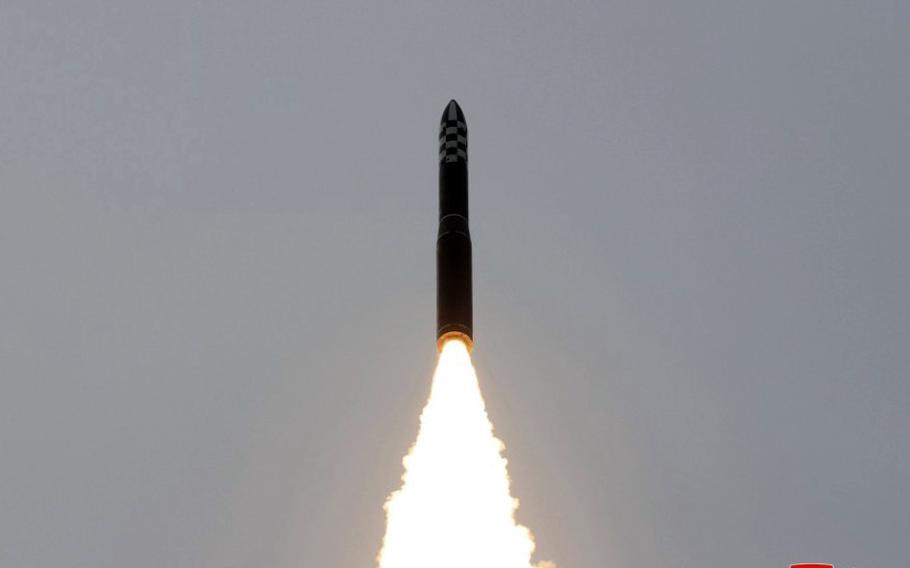
North Korea launched a solid fueled Hwasong-18 intercontinental ballistic missile, April 13, 2023, according to the state-run Korean Central News Agency. (KCNA)
CAMP HUMPHREYS, South Korea — The United States, South Korea and Japan rehearsed their seaborne missile defense in international waters on Monday, four days after North Korea launched another ballistic missile.
The guided-missile destroyers Yulgok Yi I, the USS Benfold and the JS Atago trained together in the Sea of Japan, or the East Sea, South Korea’s Ministry of National Defense said in a news release Monday. All three are equipped with the Aegis Combat System, shown capable in tests of intercepting ballistic missiles.
The drill included detecting and tracking simulated ballistic missiles and sharing that information between the ships, according to the ministry.
“This is an opportunity to boost [our] trilateral security cooperation against growing North Korean nuclear and missile threats … and to firm up our navy’s readiness posture and capabilities in responding to ballistic missiles,” South Korean navy Capt. Kim Ki Young, commander of the Yulgok Yi I, said in the release. “We will increasingly toughen our operational readiness posture through exercises that are nearly identical to actual battles.”
The drill follows what North Korea claimed was a successful test of a solid-fuel intercontinental ballistic missile on Thursday. The new ICBM, dubbed the Hwasong-18, boosts North Korea’s “nuclear counterattack posture” and offensive capabilities, according to a Friday report from the state-run Korean Central News Agency.
South Korea’s military described the projectile as a medium- to long-range ballistic missile that flew an estimated 620 miles before splashing down in the sea; Japan’s Joint Staff said it suspected the launch vehicle was a high-angle ICBM.
The launch prompted Japan to issue a brief evacuation warning to residents in Hokkaido.
It also prompted South Korean and Japanese military aircraft to conduct separate air power demonstrations with the U.S. Air Force the next day.
Two B-52H Stratofortress bombers, two KC-135 Stratotankers and four F-35 Lightning IIs flew alongside four Japan Air Self-Defense Force F-15 fighters over the Sea of Japan, U.S. Indo-Pacific Command said in a news release Friday.
The same day, B-52Hs and F-16 Fighting Falcons flew together over South Korean airspace with South Korean F-35As and F-15K Slam Eagles, according to the Ministry of National Defense.
Military aircraft from the U.S. and South Korea also began a large-scale, 12-day air exercise Monday. More than 110 aircraft, including the Marine Corps’ F-35B, are scheduled to fly during the exercise to “reaffirm the solid [U.S.-South Korea] alliance,” the ministry said in a statement.
North Korea, which launched 12 ballistic missiles in nine separate days of testing so far this year, condemned the drills as a declaration of war.
Since April 7, the communist regime has remained unresponsive to routine, diplomatic phone calls from South Korea. The countries make two calls each weekday through a military hotline to ensure a line of communication remains open.